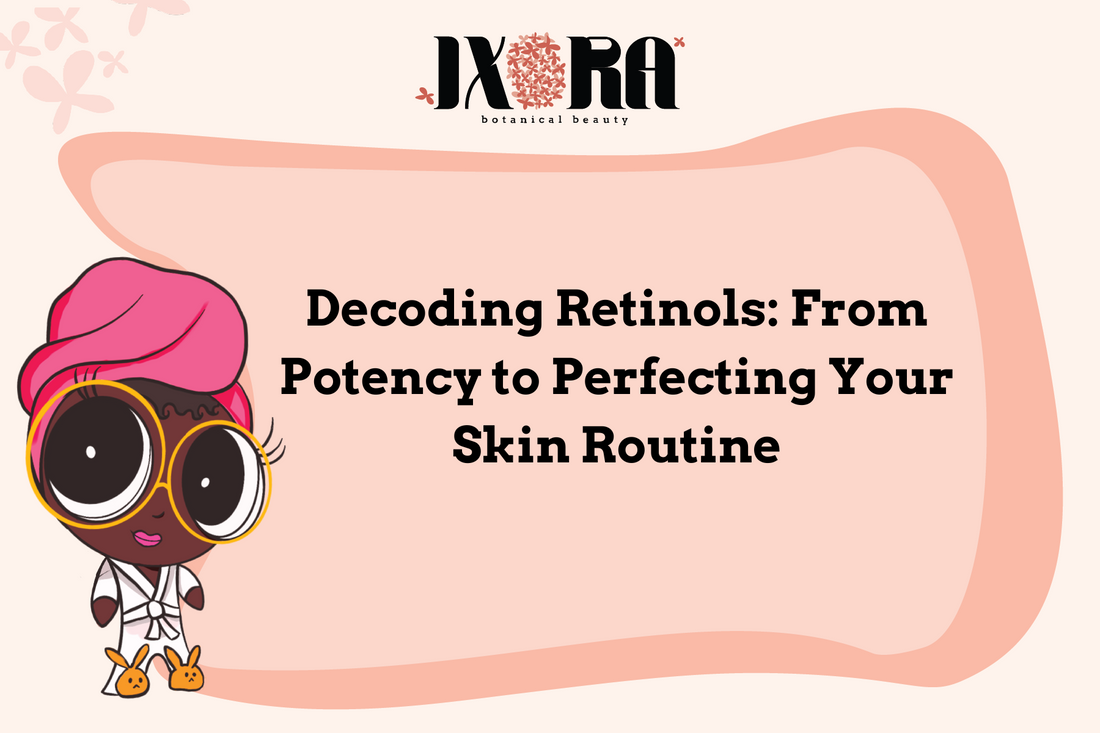
Decoding Retinols: From Potency to Perfecting Your Skin Routine
Share
Retinol is one of the most revered ingredients in skincare, but not all retinols are created equal. With various forms, strengths, and formulations, knowing where to start and how to incorporate it into your routine can be overwhelming. Let’s break down what you need to know about retinol, from its most potent form down to beginner-friendly options like our Donkey Milk & Bakuchiol: Retinol Treatment.
What Is Retinol?
At its core, retinol is part of the retinoid family—derived from vitamin A—which works wonders in improving skin texture, boosting cell turnover, and combating signs of aging. It comes in different strengths, with some forms more potent than others:
-
Retinoic Acid (Tretinoin): The strongest and most effective form of vitamin A. It’s only available via prescription and works directly on skin cells, making it the most potent for reducing wrinkles, acne, and hyperpigmentation. However, it's often associated with dryness, irritation, and peeling, especially in sensitive skin.
- Retinaldehyde: A lesser-known form of retinoid, retinaldehyde is one step closer to retinoic acid in the conversion process, making it stronger than retinol but gentler than tretinoin.
-
Retinol: This is the gold standard for over-the-counter retinoids. It converts into retinoic acid once absorbed by your skin, making it milder than tretinoin but still highly effective over time.
-
Encapsulated Retinol: Retinol is surrounded by a protective shell, allowing it to release slowly into the skin. This makes encapsulated retinol a great option for those with sensitive skin or those new to retinoids, as it minimizes the irritation often associated with standard retinol.
-
Retinyl Palmitate: The gentlest retinoid, this form is best for people with very sensitive skin or those just starting out with anti-aging products. It takes more time and effort to show results but offers a mild introduction to retinoid benefits.
Where Does Retinol Belong in Your Routine?
If you’re using retinol in serum form, it’s best placed after cleansing and toning but before moisturizing. Since retinoids can sometimes cause dryness or irritation, follow up with a good moisturizer to hnourish and protect your skin barrier. Always layer on SPF in the morning because retinol can make your skin more sun-sensitive.
Retinol During Pregnancy or Nursing
One important caveat: if you’re pregnant or nursing, it’s best to avoid retinoids altogether, including retinol. Vitamin A derivatives have been linked to birth defects, and while the risk from topical retinoids is low, it’s better to be cautious. Consider alternatives like bakuchiol or niacinamide for skincare during these phases.
Why We Recommend Donkey Milk & Bakuchiol: Retinol Treatment
For sensitive skin or those just stepping into the world of retinoids, our Donkey Milk & Bakuchiol: Retinol Treatment is the perfect choice. It combines encapsulated retinol, which releases slowly and lessens the potential for irritation, with:
- Mushroom Peptide: Provides hydration and helps soothe the skin while boosting its natural moisture barrier.
- Fullerene: An antioxidant powerhouse that aids in neutralizing free radicals, further protecting your skin from damage.
Together, these ingredients make this treatment gentle yet effective, giving your skin the benefits of retinol without the harsh side effects.
When Should You Start Using Retinol?
While there isn’t a set age to begin using retinol, dermatologists often recommend starting in your mid to late 20s. This is when collagen production begins to slow, and retinol can help keep your skin smooth, even-toned, and youthful for longer.
What Are the Benefits of Retinol?
Retinol is a powerhouse for skin rejuvenation. Here’s what it can do for your skin:
- Reduces Fine Lines and Wrinkles: By increasing cell turnover and stimulating collagen production, retinol smooths out fine lines and wrinkles.
- Improves Skin Texture: Retinol helps exfoliate the skin’s surface, leading to a smoother and more even texture.
- Fades Dark Spots: It can lighten hyperpigmentation by encouraging faster turnover of discolored skin cells.
- Fights Acne: Retinol prevents clogged pores and helps treat active acne, making it ideal for both acne-prone and aging skin.
When to Use Retinol in Your Routine
Retinol is best used at night. Sun exposure can degrade the product, reducing its effectiveness, so nighttime application is ideal. As a bonus, your skin repairs itself while you sleep, and retinol works with your skin’s natural regeneration process.
Can You Use Retinol in the Summer?
Yes! Contrary to popular belief, you can use retinol year-round—including in the summer—as long as you’re diligent about sun protection. Since retinol increases skin sensitivity to the sun, applying a broad-spectrum SPF 30 or higher every morning is essential to avoid any UV-induced damage.
Final Thoughts
Retinol is a game-changer in skincare when used correctly. From boosting collagen to treating acne and smoothing out skin texture, it’s a versatile ingredient for all skin types. And with options like our Donkey Milk & Bakuchiol: Retinol Treatment, even those with sensitive skin can enjoy its benefits with minimal irritation. Whether you're just starting in your 20s or you're looking to refine your skincare routine, retinol can help your skin age gracefully while keeping it healthy and vibrant.
